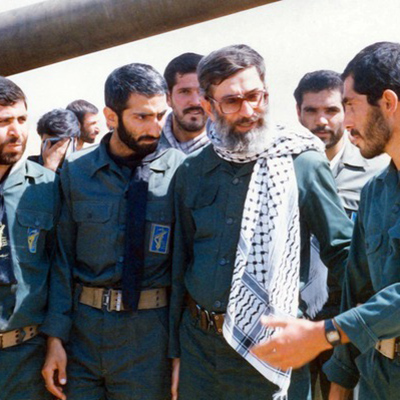Groups, Institutions, Organiza
31st Ashura Division
Fatemeh Khademi
167 Views
The 31st Ashura Division is one of the units of the Islamic Revolutionary Guard Corps (IRGC) Ground Force in northwest Iran. During the Iran-Iraq War, most of the forces of this division were from Azerbaijan.
The formation of the 31st Ashura Division dates back to May 1979, when (coinciding with the establishment of other IRGC headquarters) the Tabriz IRGC was founded in the former headquarters of the National Intelligence and Security Organization (SAVAK), under the command of Hamed Dadizad.[1] By early 1980, Abolhassan Aal-Eshaq assumed command of the Tabriz IRGC. In mid-1980, the IRGC Region 5 was formed to ensure security in East Azerbaijan (including East Azerbaijan and Ardabil) and West Azerbaijan provinces in northwest Iran, with its headquarters in Tabriz under the command of Sadeq Mahsouli. Cities in these provinces, including both Azeri- and Kurdish-speaking areas, were placed under its jurisdiction. In the meantime, Rahman Dadman replaced Aal-Eshaq as commander of the Tabriz IRGC, with Hamid Chit-chian appointed as his deputy.[2] The IRGC Region 5 participated in operations carried out to counter anti-revolutionary forces in Kurdistan, clearing areas such as Naqadeh, Saqqez, Oshnavieh, Piranshahr, Sardasht, Shahin-dej, Takab, Boukan, and Divandarreh.[3]
Following the Iraqi invasion of Iran, the people of Azerbaijan were deployed to the frontlines as volunteers. On October 4, 1980, the first group of forces of the IRGC Region 5, led by Nader Barpour, was deployed to southern Iran and stationed in Farsiyat.[4] Simultaneously, other troops, commanded by Einollah Taqavi, were sent to Abadan. Organized into 26-member groups (known as the 26 Al-Mahdi (as) Chieftain Riders) under the leadership of Mahdi Bakri, Hassan Shafizadeh, and Hamid Bakeri, they reinforced the Zulfaqari and Station 7 frontlines. In the first half of 1981, a combat group from Maragheh, led by Reza Kheiri Boloukabadi, was dispatched to Dezful and positioned along defensive lines near the Karkheh River.[5]
IRGC Region 5 played a role in breaking the siege of Susangerd (November 1980) and participated in operations such as Nasr (January 1981), Imam Ali (as) (May 1981), Imam Mahdi (as) (March 1981), Tarrah (July 1981), Shahid Madani (September 1981), and Thamen al-Aemma (as) (September 1981).
The forces of the IRGC Region 5 (East and West Azerbaijan) were organized as the 31st Ashura Brigade under the command of Muhammad-Ali (Aziz) Jafari and deployed in the Susangerd axis.[6] The Ashura Brigade was later expanded to include forces from Tabriz, Tehran, Shiraz, Shahroud, and Kazerun. After combat units were assigned to the IRGC’s eleven headquarters, the Ashura Brigade was transferred to IRGC Region 5, with East and West Azerbaijan responsible for providing manpower and general logistical support. In addition to securing Kurdish areas and supplying forces for the Hamzeh Seyyed al-Shuhada (as) Headquarters (155th Special Shuhada Brigade), West Azerbaijan provided personnel for the 31st Ashura Brigade from cities such as Khoy, Salmas, Maku, Miandoab, and Naqadeh.
The Ashura Brigade comprised seven combat battalions, headquarters units in southern Iran, and combat support units in the northwest. The Martyr Barati School at Ahvaz Railway Square served as the main command headquarters, with three other schools and camps behind the Khuzestan Hosseiniyeh Station designated as battalion bases.
During operations Fath al-Mobin (March 1982) and Beit al-Muqaddas (April 1982), Mahdi Bakeri, the deputy of Ahmad Kazemi in the 8th Najaf Brigade, was appointed commander of the 31st Ashura Brigade.[7] Meanwhile, Hamid Bakeri, who commanded a battalion in the Najaf Ashraf Brigade, joined the 31st Ashura Brigade and led the troops engaged in the first axis during Operation Moslem ibn Aqeel (October 1982).[8]
Following Operation Moslem ibn Aqeel (October 1982), the Ashura Brigade, under Mahdi Bakeri’s command, was upgraded to a division and deployed to Fakkeh. It participated in Operation Preliminary Valfajr (February 1983) with three brigades: Brigade 1 (commanded by Morteza Yaghchian), Brigade 2 (Nasser Amini), and Brigade 9 (Hamid Bakeri).
The 31st Ashura Division played significant roles in operations Valfajr 1 (April 1983), Valfajr 2 (July 1983), Valfajr 4 (October 1983), and Kheibar (February 1984).[9] At the time, Hamid Bakeri served as deputy commander of the division. In Operation Kheibar (February 1984), while leading breakthrough battalions, he managed to breach the enemy lines in southern Majnoon Island and seize Shahitat Bridge, the only land connection to the Majnoon Islands. After three days of resisting relentless enemy counterattacks, Bakeri was martyred on February 25, 1984.[10] Following Operation Kheibar and the reinforcement of positions on the Majnoon Islands, the Iranian forces deployed from Zanjan (excluding Qazvin) left the 17th Ali ibn Abi Talib (as) Division and joined the 31st Ashura Division.[11]
In Operation Badr (March 1985), crossing the Hoor, capturing the eastern bank of the Tigris, and blocking the Amara-Basra Highway[12] faced challenges such as water-based logistics and the lack of connecting roads and artillery support. Although the 31st Ashura Division was among the most successful units in crossing the Hoor, seizing the eastern Tigris, and navigating the river in this amphibious operation,[13] the mission ended without achieving its main objectives. Mahdi Bakeri (division commander), Ali Tajallaei (IRGC specialized training officer), Akbar Javadi (demolition battalion commander), Asghar Qassab Abdollahi (Imam Hussain (as) Battalion commander), Mahmoud Golzari (RPG special company commander),[14] and some other key figures were martyred in this operation.[15]
After Operation Badr, forces from Qazvin also joined the 31st Ashura Division.[16] In June 1985, Amin Shariati succeeded Martyr Mahdi Bakeri as commander of the 31st Ashura Division.[17]
In Operation Valfajr 8 (February 1986), the division, as part of the Karbala Headquarters, crossed the Arvand River, reached the Char-bagh concrete and multi-level dock, cleared enemy positions, and advanced to the Faw-Basra Road.[18] After this operation, the Qazvin forces of the 31st Ashura Division joined the 10th Seyyed al-Shuhada (as) Division.[19]
The 31st Ashura Division also took part in operations Karbala 4 (December 1986), Karbala 5 (January 1987), Karbala 8 (April 1987), Nasr 7 (August 1987), Beit al-Muqaddas 2 (January 1988), Beit al-Muqaddas 3 (March 1988), and Mersad.[20]
Following the reorganization of the IRGC in early 1988, the East Azerbaijan IRGC merged with the 31st Ashura Division to form the 5th Baqer al-Uloom (as) Corps of the IRGC, commanded by Ali Shamshiri with Amin Shariati as deputy. Its combat structure included Brigade 31 Imam Zaman (as) (Tabriz), Brigade 36 Ansar al-Mahdi (as) (Zanjan), Brigade 37 Hazrat Abbas (as) (Ardabil), Brigade 82 Sahib al-Amr (as) (Qazvin), and Neinava (Qaem).[21] After Operation Beit al-Muqaddas 3, the 5th Baqer al-Uloom (as) Corps was renamed the 5th Ashura Corps of the IRGC, with Ali Shamshiri and Amin Shariati remaining as commander and deputy commander respectively. The 5th Ashura Corps consisted of three brigades (31 Imam Zaman (as), 36 Ansar al-Mahdi (as), 37 Hazrat Abbas (as)) and four battalions (Imam Hussain (as), Amir al-Momenin (as), Ali ibn Abi Talib (as), Hazrat Qassem (as)).[22]
Operation Mersad, launched on July 27, 1988, was the most critical mission in which the 5th Ashura Corps engaged. Deploying three brigades under the Najaf Headquarters command, it attacked the Munafiqeen Group in the Hasanabad plain and pass and cleared the operational area.
In Operation Mersad, Ali Shamshiri, commander of the 5th Ashura Corps, and Ruhollah Shakuri, commander of the Ali ibn Abi Talib (as) Battalion, were martyred.[23]
From Operation Preliminary Valfajr to Mersad, the 31st Ashura Division recorded its highest number of martyrs in Operation Karbala 5 (996), the most wounded in Operation Badr (2370), and the greatest number of prisoners of war (50) and missing in action (942) in Operation Kheibar.[24]
Throughout the eight-year Iran-Iraq War, the 31st Ashura Division recorded 3684 martyrs, 12660 wounded, 287 chemical attack victims, 364 prisoners of war, and 1623 missing in action.[25]
The commanders of the 31st Ashura Brigade include Muhammad-Ali Jafari (1981), Amin Shariati (1981–1982), and Mahdi Bakeri (1982). Also, Mahdi Bakeri (1982–1984) and Amin Shariati (1985–1987) served as the commanders of the 31st Ashura Division. The 5th Baqer al-Uloom (as) Corps of the IRGC was led by Ali Shamshiri (1987–1989) and Muhammad-Jafar Asadi (1989–1991). From 1991 to 2009, the Ashura Corps was commanded by Muhammad-Jafar Asadi, Abdulmuhammad Raoufi-Nejad, Yazdan Moeidynia, Muhammad Pakpour, Ali-Akbar Nouri, and Muhammad-Taqi Osanlou. Since 2009, Muhammad-Taqi Osanlou has served as the commander of the 5th Ashura Corps.[26]
In 1994, the Congress for Commemorating the Martyrs and Martyred Commanders of Azerbaijan (East Azerbaijan, West Azerbaijan, Ardabil, and Zanjan) was organized to be held in Tabriz, officially beginning its activities in April 1995. Thousands of documents, memories, wills, and biographies of martyrs were collected, resulting in the publication of five books namely Khodahafez Sardar (Goodbye Commander), Rahiyan-e Shatt (Pilgrims of the Shatt), Setare-ye Badr (Star of Badr), Ashna-ye Aseman (A Companion of the Sky), and Gomshodegan-e Majnoon (The Losts of Majnoon). The books were unveiled at the congress on July 24, 1995.[27]
In the fall of 2004, the Institute for Preserving the Works and Promoting the Values of the Sacred Defense affiliated with this division was founded on Jomhouri Eslami Street in Tabriz.[28]
Following the restructuring of the IRGC and the formation of the Basij Organization in 2009, the East Azerbaijan Basij Headquarters merged with the 31st Ashura Division, forming the Ashura Provincial Corps of the IRGC under the command of Brigadier General Muhammad-Taqi Osanlou. Since October 2021, Second Brigadier General Asghar Abbasqolizadeh has served as the commander of the Ashura Corps of the IRGC in East Azerbaijan.[29]
[1] Maboudi, Jalal, Atlas-e Lashkar-e 31 Ashura (Atlas of the 31st Ashura Division), Tehran, Markaz-e Asnad va Tahqiqat-e Defa Muqaddas-e Sepah, 1st ed., 1398, p. 14.
[2] Ibid., Pp. 14, 18.
[3] Ibid., p. 19.
[4] Ibid., p. 21.
[5] Ibid., Pp. 32, 33.
[6] Ibid., Pp. 32, 43.
[7] Ibid., p. 46.
[8] Ibid., p. 139.
[9] Ibid., p. 48.
[10] Ibid., p. 139.
[11] Ibid., p. 48.
[12] Allahyari-Far, Muhammad, Lashkar-e 31 Ashura dar Amaliyat-e Valfajr 8 (31st Ashura Division in Operation Valfajr 8), Tehran, Markaz-e Asnad va Tahqiqat-e Defa Muqaddas-e Sepah, 1st ed., 1396, Pp. 22–23.
[13] Ibid., p. 31.
[14] Maboudi, Jalal, Ibid., Pp. 154, 155; Allahyari-Far, Muhammad, Ibid., p. 21.
[15] Allahyari-Far, Muhammad, Ibid., p. 21.
[16] Maboudi, Jalal, Ibid., p. 48.
[17] Allahyari-Far, Muhammad, Ibid., p. 22.
[18] Ibid.
[19] Maboudi, Jalal, Ibid., p. 48.
[20] Ibid.
[21] Ibid., p. 50.
[22] Ibid., p. 236.
[23] Ibid.
[24] Ibid., p. 50.
[25] Abedi Qeshlaqi, Mostafa, Shenasa-name-ye Lashkar-e 31 Ashura dar Doran-e Defa Muqaddas (Profile of the 31st Ashura Division during the Sacred Defense), Tehran, Markaz-e Asnad va Tahqiqat-e Defa Muqaddas-e Sepah, 1st ed., 1400, p. 31.
[26] Allahyari-Far, Muhammad, Ibid., p. 55.
[27] Ibid., p. 250.
[28] Ibid., p. 244.
[29] Allahyari-Far, Muhammad, Ibid., p. 55; Khabargozari Fars (Fars News Agency), No. 60021, 6 Aban 1400.





